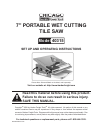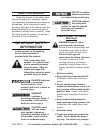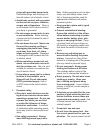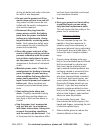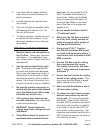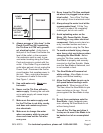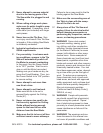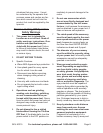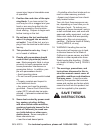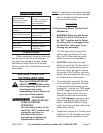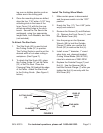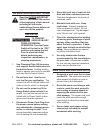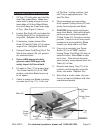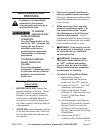Page 3SKU 40315 For technical questions, please call 1-800-444-3353.
plugs with grounded power tools.
Unmodied plugs and matching out-
lets will reduce risk of electric shock.
b. Avoid body contact with grounded
surfaces such as pipes, radiators,
ranges and refrigerators. There is
an increased risk of electric shock if
your body is grounded.
c. Do not expose power tools to rain
or wet conditions. Water entering
a power tool will increase the risk of
electric shock.
d. Do not abuse the cord. Never use
the cord for carrying, pulling or
unplugging the power tool. Keep
cord away from heat, oil, sharp
edges or moving parts. Damaged
or entangled cords increase the risk
of electric shock.
e. When operating a power tool out-
doors, use an extension cord suit-
able for outdoor use. Use of a cord
suitable for outdoor use reduces the
risk of electric shock.
f. If operating a power tool in a damp
location is unavoidable, use a
Ground Fault Circuit Interrupter
(GFCI) protected supply. Use of
a GFCI reduces the risk of electric
shock.
3. Personal safety
a. Stay alert, watch what you are do-
ing and use common sense when
operating a power tool. Do not use
a power tool while you are tired
or under the inuence of drugs,
alcohol or medication. A moment
of inattention while operating power
tools may result in serious personal
injury.
b. Use safety equipment. Always
wear ANSI-approved eye protec-
tion. Safety equipment such as dust
mask, non-skid safety shoes, hard
hat, or hearing protection used for
appropriate conditions will reduce
personal injuries.
c. Keep guards in place and in good
working order.
d. Prevent unintentional starting.
Ensure the switch is in the off-po-
sition before connecting to power
source and/or battery pack, pick-
ing up or carrying the tool. Carry-
ing power tools with your nger on
the switch or energizing power tools
that have the switch on invites acci-
dents.
e. Remove any adjusting key or
wrench before turning the power
tool on. A wrench or a key left at-
tached to a rotating part of the power
tool may result in personal injury.
f. Do not overreach. Keep proper
footing and balance at all times.
This enables better control of the
power tool in unexpected situations.
g. Dress properly. Do not wear loose
clothing or jewelry. Keep your
hair, clothing and gloves away
from moving parts. Loose clothes,
jewelry or long hair can be caught in
moving parts.
h. If devices are provided for the con-
nection of dust extraction and col-
lection facilities, ensure these are
connected and properly used. Use
of these devices can reduce dust-
related hazards.
4. Power tool use and care
a. Do not force the power tool. Use
the correct power tool for your ap-
plication. The correct power tool will



